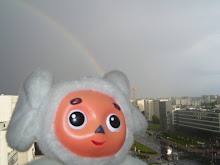The Stare Miasto is one of Poland's finest jewels. The Sukiennice (cloth hall), which was the world's first department store, stands in the center and is home to many shops and stalls, with a fine art museum at top. The museum is undergoing renovation, so it'll be out of business until something like 2010. (Work goes very slowly here in Poland.) St. Mary's Church is staggeringly beautiful inside. A royal blue ceiling, painted with tiny golden stars, creates the impression of a heavenly sky.

The Sukiennice at night
The district of Kazimierz (also named for Kazimierz the Great) was the Jewish section of Krakow until WWII. Most times I been there I've gotten lost, and to be perfectly honest, it's really not that great. There are several synagogues, which are now museums, and only one, the Old Synagogue, is really worth a visit. It holds many Jewish artifacts. The Jewish cemeteries are quite nice, with the older, smaller one dating back to the 16th century. I have only visit the larger, newer on, and only that during winter. Huge, vine-covered trees tower over a small forest of stone. Paths wind about through the raised graves. It was quite peaceful to visit during a light snowfall. It was also convenient to be wearing a winter hat, since men must don hats in accordance to the rules.
I only once went to the nearby park of Ojcow (Fathers'.) Apparently it is quite nice to bike and hike to see the castle ruins in them as well as the natural beauty. I was not able to see any of these ruins, but walked along a frozen road to find the "hamlet" (a scattering of houses that makes Somesville look like a roaring metropolis) in which everything was closed. Since bus service was not exactly on frequent intervals we had to walk to the nearby town, whose name escapes me at the moment.
The Wawel, like all main tourist sights, is mobbed with an un-godly amount of people. Lines form to go inside the cathedral, which is no small chapel. Throngs of misshapen Brits drink overpriced coffee and laugh like idiots over the most numbingly retarded observations. If you hate tourists as much as I do, visit Krakow in the dead of winter or even in early spring. Warsaw may be the entry point to these unsightly masses of flesh, but they soon cram their fat asses into buses or trains and head to Krakow.

The Zygmunt Bell in the Wawel Cathedral
I'm tempted to compare the Wawel with the Royal Palace in Warsaw. The Wawel was head of the Nazi command, so it escaped the fate of the Royal Palace. The Royal Palace was painstakingly rebuilt, finished 1988. The Royal Palace is far more opulent (and has the most amazing bathroom in Poland. It's even better than the mens' room in Gunness at UMass.) But the Wawel still is pretty cool. One can climb to see the Zygmunt Bell and from the bell tower see the whole of the Krakow Stare Miasto. The Wawel has a Cathedral, which is very beautiful, which the Royal Palace doesn't have and the Wawel has far better landscaping. One can walk about on Wawel hill and then descend for a walk along the Vistula.

The Opera House in Krakow






No comments:
Post a Comment